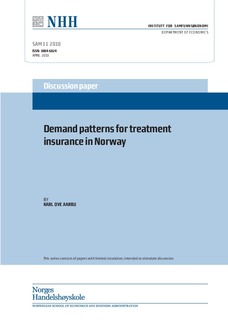| dc.description.abstract | In Scandinavia, the provision of health care services has been, almost entirely, the
responsibility of the public health care system. However, in the last five to seven years there
has been remarkable growth in the private health care market. These health care services are
obtained normally through insurance contracts. In this paper, I seek explanations for this
phenomenon, using data from Norway. First, using available market data, I document that
the market for private treatment insurance—often labelled as “jump the treatment queue
insurance”—is growing rapidly. Thereafter, I present a theoretical model that identifies
primary drivers for individual demand for treatment insurance. The third step is to analyse a
unique survey data set that is combined with aggregate county data on treatment queues. The
overall results indicate that public waiting lists affect the demand for privately bought
insurance, while employer-provided insurance does not seem to be affected. I find strong
preference for this type of insurance among smokers and the self-employed. Moreover,
income is an important determinant of insurance demand. | en |
